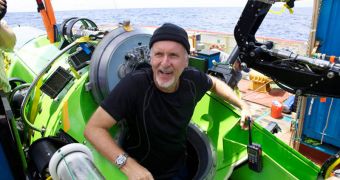Back in March, daredevil James Cameron set out on a quest to explore the Mariana Trench and succeeded in reaching the depth of 10,900 meters (6.772 miles).
Seeing how the Mariana Trench is presently the deepest part of the world's oceans, it need not come as a surprise that members of the scientific community were as enthusiastic about James Cameron's going public with what he found there as Avatar fans are about the upcoming sequel to said blockbuster.
The wait is now over, as it was only this past Tuesday when James Cameron presented some of his findings to a meeting of the American Geophysical Union, which took place in San Francisco.
As far as biology goes, James Cameron discovered that, when compared to the New Britain Trench he previously explored while preparing for his Deepsea Challenge, the Mariana Trench is pretty much a desert.
After personally taking his Deepsea Challenger to the bottom of the ocean, James Cameron also sent this submersible to carry out an exploration mission on its own.
While diving solo, the Deepsea Challenger visited two spots on the seafloor of the Mariana Trench, one of which was a basin referred to as the Serena Deep, Nature reports.
It was here where the submersible came across outcrops and microbial communities.
Astrobiologist Kevin Hand made a case of how, “What was very exciting about the Serena Deep dive was we could see outcrops and bizarre microbial mats covering the rocks.”
In case anyone was wondering, finding these outcrops and microbial communities at the bottom of the ocean provides new clues with respect to how life first came about on Earth.
This is because these outcrops supposedly contain rocks coming from the mantle, whose mineral content is being toyed with by the seawater.
Once these minerals react with the surrounding aquatic environment, hydrogen and methane are released, and these two chemical compounds later on feed the microbial communities in their proximity.
“Serpentenization [the process by which sea water reacts with minerals] is seen to be a possible culprit in that step between geochemisty and biochemistry,” Kevin Hand explains.
For the time being, James Cameron is still unsure with respect to the exact date when he will revisit the Mariana Trench, but says he is definitely considering embarking on similar future missions.

 14 DAY TRIAL //
14 DAY TRIAL //